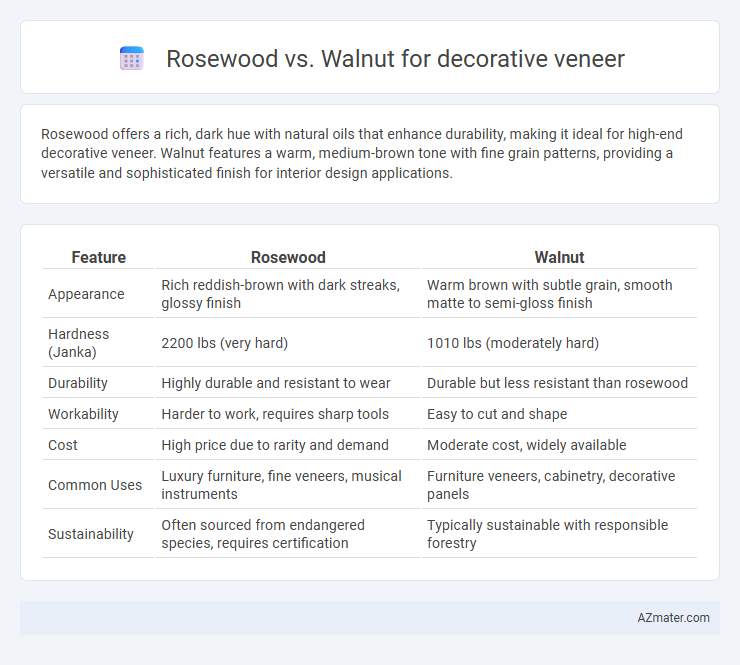Rosewood offers a rich, dark hue with natural oils that enhance durability, making it ideal for high-end decorative veneer. Walnut features a warm, medium-brown tone with fine grain patterns, providing a versatile and sophisticated finish for interior design applications.
Table of Comparison
| Feature | Rosewood | Walnut |
|---|---|---|
| Appearance | Rich reddish-brown with dark streaks, glossy finish | Warm brown with subtle grain, smooth matte to semi-gloss finish |
| Hardness (Janka) | 2200 lbs (very hard) | 1010 lbs (moderately hard) |
| Durability | Highly durable and resistant to wear | Durable but less resistant than rosewood |
| Workability | Harder to work, requires sharp tools | Easy to cut and shape |
| Cost | High price due to rarity and demand | Moderate cost, widely available |
| Common Uses | Luxury furniture, fine veneers, musical instruments | Furniture veneers, cabinetry, decorative panels |
| Sustainability | Often sourced from endangered species, requires certification | Typically sustainable with responsible forestry |
Introduction to Decorative Veneers
Decorative veneers like Rosewood and Walnut are prized for their distinctive grain patterns and rich hues, enhancing furniture and interior design with natural elegance. Rosewood offers deep reddish-brown tones with striking, dense grain, ideal for luxurious finishes, while Walnut provides a smooth, consistent texture with warm chocolate-brown shades, favored for classic and contemporary applications. Choosing between Rosewood and Walnut veneers depends on the desired aesthetic impact, durability, and the specific wood characteristics suitable for high-end decorative surfaces.
Overview of Rosewood Veneer
Rosewood veneer is prized for its rich, dark brown hues with striking black or reddish streaks, creating a luxurious and exotic appearance ideal for high-end decorative applications. Its dense grain and smooth finish provide excellent durability and a polished look that enhances furniture, cabinetry, and wall panels. Compared to walnut, rosewood offers a more dramatic visual impact with unique color variations, making it a preferred choice for statement pieces in interior design.
Overview of Walnut Veneer
Walnut veneer, prized for its rich chocolate-brown hues and intricate grain patterns, offers a versatile and luxurious finish for decorative applications. Known for its durability and smooth texture, walnut veneer enhances both modern and traditional interiors by adding warmth and elegance. It is often favored over rosewood for its more subtle, sophisticated appearance and sustainable sourcing.
Appearance and Color Variations
Rosewood veneer displays a rich spectrum of deep reddish-brown tones with distinctive dark veining, offering a luxurious and exotic appearance. Walnut veneer features a warm, chocolate-brown base with subtle purples and occasional light streaks, creating a classic and versatile look. Both woods provide unique color variations that enhance decorative veneer projects by adding depth and character.
Grain Patterns and Texture
Rosewood veneer features distinctive, rich grain patterns with dark streaks and a highly varied, swirling texture that adds depth and elegance to decorative surfaces. Walnut veneer offers a straighter, more uniform grain with subtle waves, providing a smooth and consistent texture ideal for modern and classic interiors. Both woods deliver unique aesthetic qualities, with rosewood emphasizing bold, dramatic patterns and walnut offering refined, understated beauty.
Durability and Longevity
Rosewood veneer offers exceptional durability due to its dense grain structure, making it highly resistant to wear and scratches, which contributes to a longer lifespan in decorative applications. Walnut veneer, while slightly softer than rosewood, provides good durability with moderate resistance to dents and abrasions, maintaining its aesthetic appeal over time. Both veneers can last for decades under proper care, but rosewood generally outperforms walnut in longevity and resilience for high-traffic or frequently handled surfaces.
Workability and Finishing
Rosewood offers excellent workability with its dense, oily texture that allows smooth cutting and carving but may require sharp tools to prevent tear-out. Walnut is easier to work with due to its moderate hardness and uniform grain, providing clean cuts and less tool wear. Both woods achieve a high-quality finish, with rosewood producing a rich, glossy surface and walnut delivering a warm, satin-like appearance ideal for decorative veneer applications.
Cost Comparison
Rosewood veneer generally commands a higher price than walnut due to its rarity and distinctive grain patterns, making it a premium choice for luxury decor. Walnut veneer offers a more affordable yet elegant alternative with rich, warm tones suitable for a variety of design styles. Budget-conscious projects typically lean towards walnut veneer, while rosewood suits high-end applications where cost is less restrictive.
Sustainability and Environmental Impact
Rosewood veneer often raises sustainability concerns due to its slow growth rate and overharvesting in tropical regions, leading to habitat loss and strict trade regulations under CITES. Walnut veneer, sourced mainly from North American or European forests, tends to have a lower environmental impact thanks to more sustainable forestry practices and faster regrowth cycles. Choosing walnut over rosewood for decorative veneer supports better forest management and reduces pressure on endangered species.
Best Applications for Rosewood and Walnut Veneers
Rosewood veneers excel in luxury furniture, musical instruments, and high-end cabinetry due to their rich, dark tones and dramatic grain patterns that add elegance and warmth. Walnut veneers are ideal for modern and classic interiors, including wall paneling, office furniture, and decorative accents, offering a smooth texture and consistent color ranging from light to dark brown. Both veneers enhance aesthetic appeal, but rosewood is favored for striking visual impact, while walnut provides versatility and timeless sophistication.

Infographic: Rosewood vs Walnut for Decorative veneer
 azmater.com
azmater.com